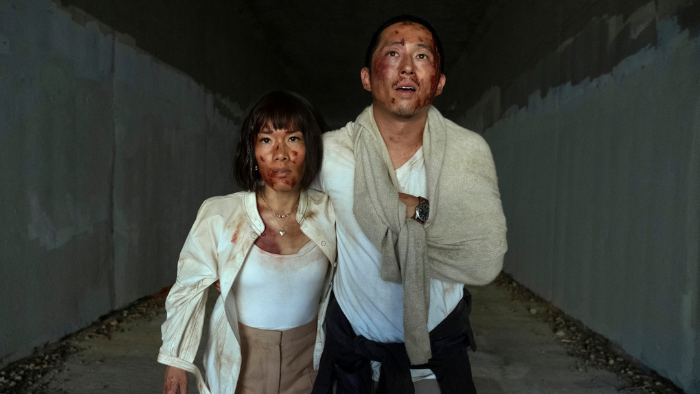Frozen In Time
A visit to Yeonpyeong Island seven months after North Korea’s shelling reveals a people and place still reeling from the damage and feeling abandoned by their own government.
Story and photos by Mark Edward Harris
AFTER ARRIVING ON THE South Korean island of Yeonpyeong via a ferry from Incheon, I took a stroll down Yeonpyeong-ro, the quiet fishing community’s seaside street. First, I passed a house where boxes of soju bottles were neatly stacked outside waiting to be sent to the mainland for recycling. Then, just a few doors down was another house whose roof had been transformed into a mangled mess of concrete and iron rods. Inside, a wall calendar was still turned to November 2010.
On the 23rd day of that month, the North Korean military launched an artillery bombardment on Yeonpyeong. That morning the North had sent a telex demanding the South halt a planned live-fire artillery exercise in waters off the islands and warned it would not tolerate firing into what it regarded as its territorial waters. Pyongyang has never accepted the western maritime border known as the Northern Limit Line established by United Nations Command in 1953, and this area has been a flashpoint between the two Koreas ever since.
[ad#300]
The South went ahead with the drill as planned, and at 2:34 p.m., North Korean coastal artillery batteries at Mudo and Kaemori opened fire on Yeonpyeong. Minutes later, South Korean guns stationed on the island returned fire in what would become the most serious artillery engagement between the North and the South since the signing of the armistice in 1953.
The more than 150 shells and rockets fired destroyed some 25 homes, warehouses and public buildings, and started fires across large areas of the island’s forests and fields. Two South Korean marines and two civilian construction workers were killed, and dozens were injured. (North Korean casualties are unknown.) As I surveyed the still-visible damage during a visit to the island in late June, I was amazed

that the casualties weren’t much higher. Monthly air-raid drills, during which residents duck into concrete bunkers carved into the sides of the mountainous island, had certainly saved many lives.
Those drills continue, and residents have taken it upon themselves, in fact, to step them up.
“During the shelling, our children were taking a nap,” recalled Park Hye-won, the principal of a daycare center on the island, speaking through a translator. “The building started shaking and windows shattered over them. First, we thought this was just a misfire from the South Korean Army because they informed us about their training that day. A few minutes later, a worried parent, who is a soldier, called and told us to move our children to the bomb shelter nearby. We only found out it was a North Korean attack after we got into the bomb shelter.”

Park said the staff and students stayed in the shelter overnight, eating instant noodles from styrofoam cups, and emerged the next morning to evacuate the island. “After this experience, we do training drills with the children twice a month, or when the South Korean Army does their training,” she said. “We’ve decided to take actions on our own for the safety of our children.”

Like the home with the destroyed roof, items frozen in time by that fateful day appeared again and again throughout the town. Further down the road in the middle of Yeonpyeong Street was a small crater created by a shell. I was struck by just how seemingly arbitrary the shells were in where they landed. The difference between life and death could, in some places, be measured in inches.
Although the government built simple row houses for those left homeless by the attack, seven months after the shelling, residents complain that little else has been done to help them.
“The government has left us with all this mess to clean up on our own,” complained Choi Ryul, a fisherman, as he stood in front of a storage freezer destroyed by an artillery shell.
[ad#bottomad]
“All they did was replace the shattered windows because it was wintertime,” described Kim Young-sik, a local motel owner. “Other damage, such as my car’s shattered window or equipment we had, was not included. Even if you have a cracked wall in your house, the government won’t repair it for you.”
It seemed unclear who would pay for clean-up efforts or rebuilding of some of the damaged structures, and that has apparently slowed down recovery, residents told me.

Kim, who makes his living providing accommodations for and renting out boats to hobby fishers, added that many locals are suffering financially as a result of the drop in visitors to the island. “It’s now high season [for fishing], but civilians as well as tourists are still afraid to come down here,” he said. “I am not sure what to do at this point.”
In the northern part of Yeonpyeong , there’s a memorial park featuring large metal maps engraved with naval battle details of two previous deadly encounters. Its existence serves as a reminder that this was not the first fatal exchange between North and South in this area known for its ripe crab fishing waters and, sadly, will not likely be the last.
[ad#336]
This article appeared in the August 2011 issue of KoreAm.
 A man rides his bike down Yeonpyeong Street, past a spot in the road where a North Korean artillery shell landed. ©Mark Edward Harris
A man rides his bike down Yeonpyeong Street, past a spot in the road where a North Korean artillery shell landed. ©Mark Edward Harris






